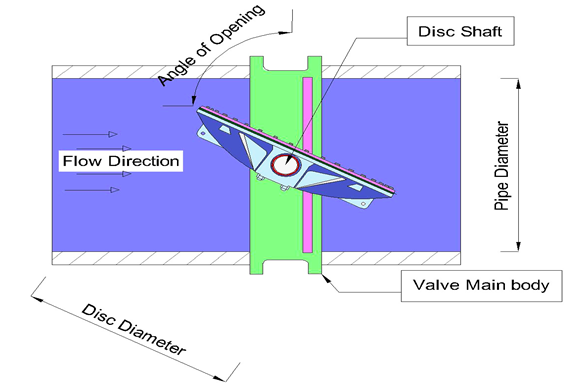The Butterfly valve (BV) is specially designed for the control, shut down, as well as activation of pipelines involving liquids as well as gases. The name comes from the way a butterfly lands with the wings moving up and down at a right angle, which is how a butterfly operates. Even though its operation sounds more like a ball valve, they are generally quarter-turn valves that allow a straight flow, bidirectional flow configuration, and step-by-step opening and closing of pipelines. They are capable of handling larger flow rates at lower pressure and fluids containing larger concentrations of suspended solids. In comparison to other categories of valves, it offers lower maintenance costs due to the small number of moving parts as well as its ability to limit the formation of vortices due to pressure variation. Butterfly valves must be installed away from pumps, other types of valves, and fittings at least 6 times the pipeline diameter to maintain recommended flow conditions.
Biomimicry literally means simulation of the living, and it is a branch of science that applies ideas from nature either to solve a problem or to invent things like the first flying machines influenced by eagles and owls. The field has evolved to current fighter jets, Boeing aircraft, etc. The technique usually adopts various ideas from nature and analyses them to see which works best. The goal of this concept is to invent sustainable and environment-friendly products without minimizing economic factors. By designing and production of items based upon natural materials and processes, we are striving for a better living harmony with nature.
Selection of Butterfly Valve
The BV finds application in numerous industries involving fluids. Since the valves are generally used for flow regulation, there are numerous instances where there is an effective loss in pressure due to skin friction while flowing through it. Apart from maintaining an insignificant pressure differential, it should also be able to bear forces from very high-velocity flows. So while selecting a particular type of BV for a specific application, many factors such as the pressure differential, total friction head loss in the pipeline, angle of opening, hydrodynamic torque, the torque acting on the surface of the valve while it is opened and closed, frictional torque against the rotation of valve shaft, packing & hub torque, hydrodynamic flow torque, coefficients of flow, and loss, must be considered.
The non-dimensional number-like flow coefficient is a major factor that plays a pivotal role in selecting BV for a particular application. The flow coefficient is proportional to the specific gravity of the fluid and inversely proportional to the pressure differential between the inlet and outlet of the valve. While many studies have shown that intermediate angles of opening for high speed as well as denser fluid flows may tend to produce higher values of flow coefficient, it tends to create vortices near the downstream pipe entrance which results in pressure loss, and this further enhanced by the roughness parameter of the internal surface.

Computational Analysis of the Biomimetic Model
Over the last few decades, many researchers have been working on technologies for improving the performance of BV by minimizing the skin friction coefficient with the aid of computational as well as experimental techniques, but most of the results were not promising due to the lack of discrepancy among the results. They also lacked technology for setting up high-precision experimentation as well as computational facilities for the same till the last decade. Now with the advancement of computational facilities as well as an emergence of a relatively new field called “biomimicry”, it is possible to analyze such complex flows by comparing similar phenomena from nature with the aid of computational techniques. The usage of the above-mentioned technologies made it possible for the researchers to analyze as well as optimize the losses encountered in pipelines and accessories.
For example, the analysis of the microstructure of shark skin is finding application in solving complicated fluid flow problems by minimizing the formation of vortices and flow separation. Sharks are generally furtive predators thanks to the structure of the skin, which is composed of small V-shaped scales, called dermal denticles resembling the shape of teeth. This microscopic and ridge-shaped denticle of varying thicknesses is distributed uniformly in the shark’s skin from the head to the tail, where thin denticles help reduce drag force while thicker denticles protect them from the attack of other predators and inhibit the parasites from bonding onto their skin. These features of shark skin have inspired many fields lately, such as the development of sleek swimsuits, better-streamlined blades of wind turbines and car bodies, microbe-resistant materials, etc.
Researchers used this concept for solving the losses as a result of skin friction and the building up of wakes downstream of a BV with the aid of computational techniques. They found that implementing hollow patterns at the internal surface as on a shark’s skin resulted in better flow conditions by shortening the interaction between the fluid particles and the surface of the flow and reduced the possibility of vortex formation, flow separation, and skin friction generation at the vicinity of BV. The computational results were quite promising at the intermediate angle of opening to 20o with a reduction of 83% skin friction coefficient, 45% lower chances of vortex formation with a notable increase in velocity as well as mass flow rate as a result of implementing the internal structure of BV similar to denticles formed in sharks.

No comments yet. Start a new discussion.